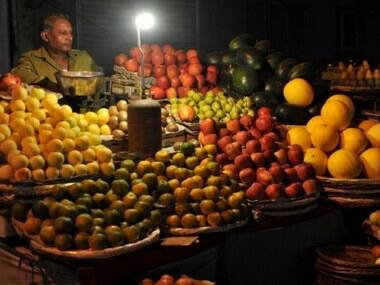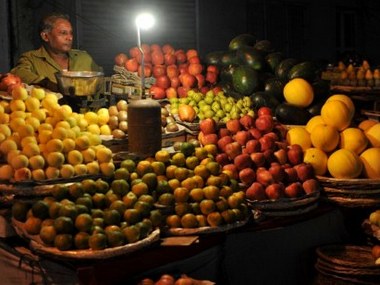Have we really understood the mechanics of inflation in the country to meaningfully look for solutions? The honest answer is probably no.
Some of the commonly held theories on inflation have been tested quite rigorously in the last two years, yet we seem to have a limited grasp on why prices are rising. It is also quite ironical that just a day after the Reserve Bank of India (RBI) slashed interest rates by 50 basis points (100 bps make 1 percent), which was based on some inner feeling that Wholesale Prices Index (WPI) inflation was down below 7 percent, the Consumer Prices Index (CPI) came in at 9.5 percent. Considering that for two years we have been combating inflation and finding reasons for the same, a high number looks a bit odd when juxtaposed with the policy action.
[caption id=“attachment_286605” align=“alignleft” width=“380” caption=“AFP”]
 [/caption]
[/caption]
There are three parts to inflation: primary, fuel and manufactured articles. The battle with prices began in 2010-11 (FY11) when food and fuel inflation was high. The so-called core inflation, which is non-food, non-fuel inflation, or roughly manufactured goods (which actually includes food products to an extent) was around 5-6 percent. Yet, the RBI chose to increase rates to bring prices down when fuel and food inflation dominated with primary product prices increasing by over 20 percent.
By the end of FY11, core inflation started moving up and reached the 8 percent mark during FY12, and has come below 5 percent by the end of March 2012. This has provided the trigger to lower rates, though assuredly the other two components remain worrisome. Can anything be done?
If we look at prices of primary products, the government has contributed to inflation through the minimum support prices (MSP) programme, where prices have been increased sharply over the last six years, ever since we had the wheat crisis of 2005-06, by 50-120 percent for most farm products. While the MSP is announced for all products, it remains relevant directly for only wheat and rice where procurement takes place. The price for paddy has increased from Rs 580 a quintal in FY06 to Rs 1,080 in FY12, while that of wheat has moved from Rs 785 to Rs 1,285 a quintal.
For arhar, it has more than doubled from Rs 1,410 to Rs 3,200, while that of moong has moved from Rs 1,520 to Rs 3,500. Maize has gone up from Rs 540 to Rs 980 while that of jowar from Rs 525 to Rs 980. However, once the MSP is raised the market price also adjusts upwards and these become benchmarks, wherein the product is priced as a mark-up on MSP.
This means that there is a self-fulfilling mechanism in place which ensures that inflation is high. Farmers have had to perforce increase their prices to adjust to inflation which has averaged 7 percent per annum in the last five years. Yields have increased by only 10 percent for foodgrains and remained unchanged for non-foodgrains in the four-year period up to FY11.
Clearly, to maintain their own consumption levels, prices have had to be increased as yields have increased at an average of 2.5 percent per annum for, say, foodgrains and output cannot make up to maintain total income levels.
A lament today is the trend of increasing prices of protein products, a new term coined in the recent past. The higher the price of coarse cereals (especially maize), the higher the cost of animal feed, which in turn has made poultry, dairy and meat products dearer. The peculiarity of these prices is that once they go up, they never return to normal as every increase sets a new normal.
The important aspect of price movements in food items is that the conventional relationship between good monsoons and good harvest and lower prices has been severed on account of this entire pricing process. With the political ascendancy of the supporters of producer classes, it has become a debate between interests of consumers and producers, where the latter are farmers. The die has been cast in favour of the producers and hence there does not seem to be any easy way out.
While the rate of food inflation may come down over time as the base effect comes in (where the index is high for the year being compared with) absolute prices are going to increase.
Two factors working towards pushing up prices to a certain extent have been relatively higher demand emanating due to the social spending programmes such as NREGA and changing tastes of consumers. While this is true, it cannot be overemphasised because while NREGA has pushed in around Rs 30,000-40,000 crore on an annual basis in the last few years, the sense is that this money would have only partly been used for conventional food products while it is more likely that it could be spent on dairy, meat and manufactured products, as the schemes are open to farmers in the lean season and not to those in penury.
But, the other important outcome, which is definitely critical, is that the NREGA programme has increased wage levels in rural areas which, combined with a shift in labour to urban areas, has pushed up the cost of cultivation, which legitimately gets reflected in the higher prices being charged. To the extent that it had contributed to inflation, it will be an important factor going ahead. Seen in this light, higher food prices may be seen as allowing farmers to also partake in the economic wealth being generated in the country!
All this means that we really do not have an answer to food inflation and breaking this chain is going to be a challenge as daunting as the issue of fuel prices. Around half the weight of fuel products, i.e. 7.5 percent, relates to prices that are controlled by the government. The conundrum here is that the government faces the following forces: global crude oil prices, excise and customs duties at our own end, the subsidy bill, the borrowing programme, the health of the OMCs (oil marketing companies), and consumer interests. Balancing all these forces is a tough job.
Crude oil prices are whimsical and the main task is to balance consumer prices with the health of the OMCs and its own fiscal deficit. In inflationary times, consumer interests have to be protected because a 10 percent increase in prices means a direct impact of between 0.5-0.75 percent on inflation and another 0.5 percent on account of higher transport and input costs which feed into higher final prices.
Now how does one subsidise the same if prices are not increased? One way is to let the OMCs take the hit, or the other, is to subsidise the same. The former makes the income statements weaker, while the latter inflates the subsidy bill and hence the fiscal deficit which affects the liquidity in the system as higher government borrowing is the result. So far, the government has taken the hit through losses for OMCs and higher deficit, which indirectly adds to inflationary pressures with a lag.
But making economically sound adjustments to fuel prices is going to be inflationary, especially in the current situation where the CPI inflation number is close to 10 percent. Clearly there are no easy solutions here.
The sense that one gets is that a large part of our inflation, i.e. around 35 percent of the index, is really out of our reach and the concentration has been on the core inflation segment which again is not quite straight forward as a large part has global influences, especially for metals, where India is a price taker. Or, we need to consciously give up something - either farmer support, or fiscal deficit or the health of OMCs to lower prices. Not really a palatable menu for the policymakers.
The end-result is that we now know where the price pressure points lie and also have an idea on what should be done to control their increase. But each ideological thought behind policies which drive prices is well framed and can actually be justified on social or economic grounds. Somebody has to take a decision to come in the way of these practices - the question is who?
(The author is Chief Economist, Care Ratings. These views are personal)
)